In the heart of Southeast Asia’s dense rainforests, an extraordinary reptile performs one of nature’s most convincing optical illusions. The vine snake, with its slender body and remarkable camouflage abilities, has perfected the art of mimicking leaves swaying in the breeze. This remarkable adaptation allows it to simultaneously hide from predators and ambush unsuspecting prey. Unlike typical camouflage that relies solely on color matching, this snake’s mimicry involves complex behavioral patterns that replicate the natural movements of vegetation. Its performance is so convincing that even experienced observers can walk right past without noticing this master of disguise hanging motionless among the foliage.
The Vine Snake’s Identity
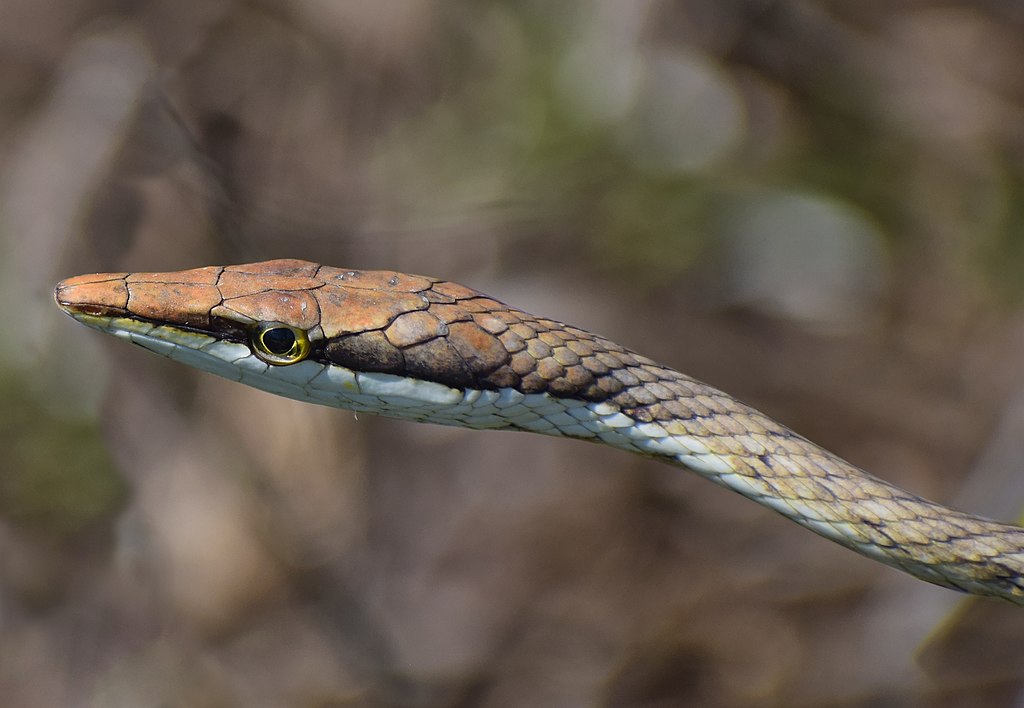
The primary species known for this remarkable leaf-mimicking behavior is the Asian vine snake (Ahaetulla prasina), though several related species in the genus Ahaetulla demonstrate similar abilities. These slender arboreal hunters range throughout Southeast Asia, from India to Indonesia, making their homes in the lush rainforests and woodland edges. Their extraordinarily thin bodies can reach lengths of up to 6 feet, though they rarely exceed the diameter of a pencil. With their vibrant green coloration and elongated heads featuring distinctive horizontal pupils, vine snakes are perfectly adapted for life among the branches and leaves of their forest habitats. Their taxonomy places them in the family Colubridae, making them distant relatives of more familiar snakes like kingsnakes and rat snakes.
Evolutionary Marvel of Mimicry
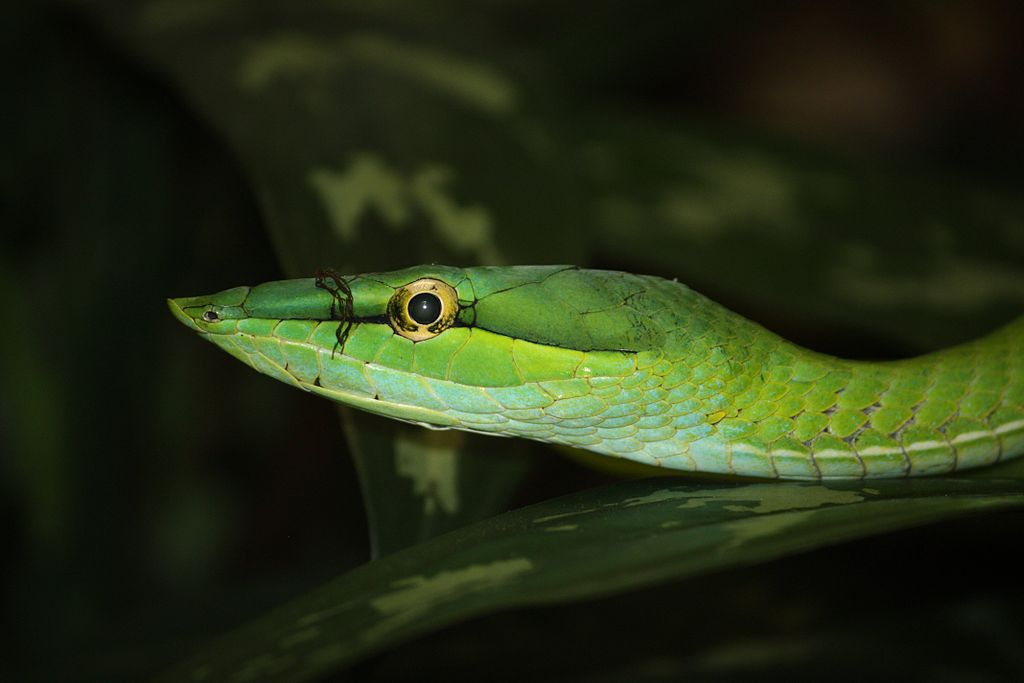
The vine snake’s ability to mimic leaves represents an evolutionary process known as crypsis, where an organism evolves to visually blend with its surroundings. This particular form of mimicry, however, goes beyond simple color matching to include behavioral adaptations that have developed over millions of years. Natural selection has favored those snakes whose body shape, color, and movement patterns most effectively resembled vegetation, giving them survival advantages in hunting and predator avoidance. The elongated snout, laterally compressed body, and even the irregular pattern of scales contribute to breaking up the snake’s outline among leaves. Perhaps most remarkable is that this mimicry isn’t just a passive resemblance but an active behavioral strategy requiring the snake to consciously maintain specific postures and movements—demonstrating the sophisticated intersection of physical and behavioral adaptations in evolutionary development.
Physical Adaptations for Disguise

Every aspect of the vine snake’s physiology contributes to its leaf-mimicking mastery. Its body displays a brilliant green coloration that precisely matches the surrounding foliage, with some individuals capable of subtle color changes to better match their immediate environment. The snake’s exceptionally thin, laterally compressed body creates a leaf-like profile when viewed from any angle. Along its underside runs a straight yellow line that mimics the central vein of a leaf, while tiny irregular patterns on its scales resemble the natural variations found on leaf surfaces. Perhaps most striking is the vine snake’s head, which is elongated into a pointed snout that resembles a leaf tip or stem, complete with a slightly rough texture that mirrors plant material. These adaptations extend to its skin texture, which lacks the shiny appearance of many other snakes and instead features a matte finish that prevents sunlight from reflecting and potentially revealing its presence.
The Remarkable Swaying Behavior

The vine snake’s most extraordinary adaptation is its distinctive swaying behavior, where it moves its body in gentle, rhythmic motions that perfectly mimic leaves being stirred by a light breeze. This behavior involves the snake holding portions of its body in rigid, straight sections while allowing others to curve gently, creating the irregular shape of a vine with leaves. When moving slowly through vegetation, the snake advances with a stop-start motion, freezing periodically in various postures that blend with surrounding plant structures. What makes this behavior particularly remarkable is how the snake can maintain these swaying movements at precisely the same tempo as surrounding vegetation responding to air currents. This synchronization is so accurate that even when no breeze is present, the snake will remain motionless, only initiating its swaying when natural air movements would cause real leaves to stir, demonstrating an incredible sensitivity to its environment.
Hunting Through Deception
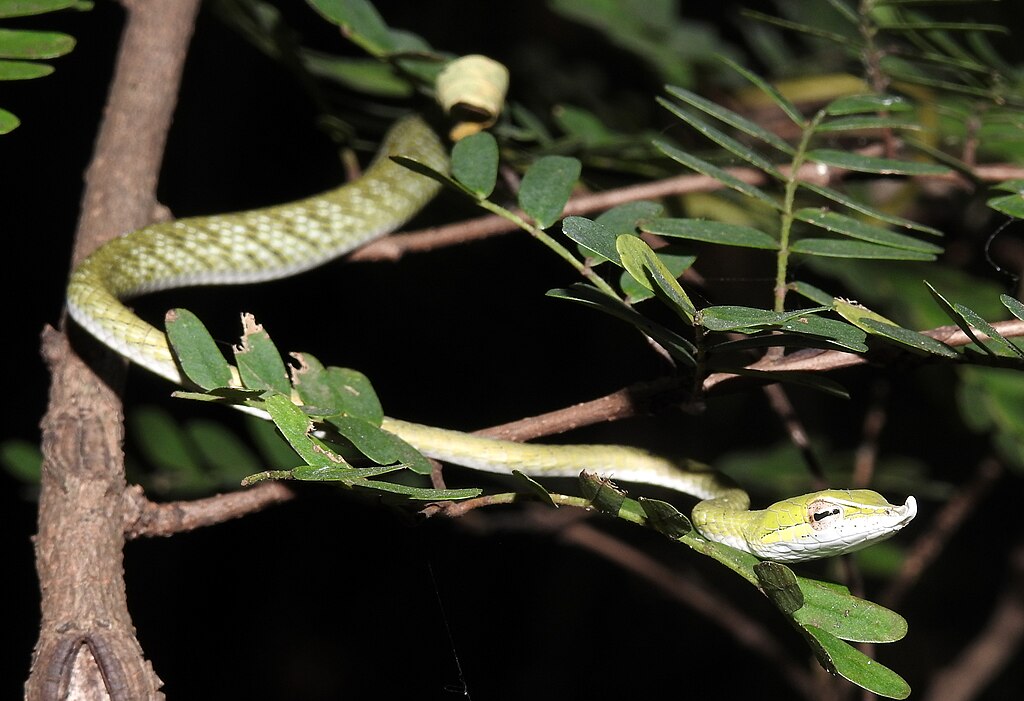
The vine snake has transformed its leaf mimicry into a lethal hunting strategy that relies on absolute stillness interrupted by explosive speed. As an ambush predator, it positions itself among branches and foliage, its body arranged in leaf-like formations, sometimes remaining frozen in position for hours while waiting for prey to approach. Small birds, lizards, and frogs make up the majority of its diet, with the unsuspecting victims often perching or hopping within inches of the disguised predator. The snake’s forward-facing eyes provide exceptional binocular vision, allowing it to judge distances with remarkable accuracy despite remaining perfectly still. When prey comes within striking range, the vine snake abandons its gentle swaying and launches forward with surprising speed, capturing its target before it can register the danger. After securing its prey with its small rear fangs, the snake delivers a mild venom that quickly immobilizes smaller creatures, allowing for safe consumption.
Visual Perception Specializations
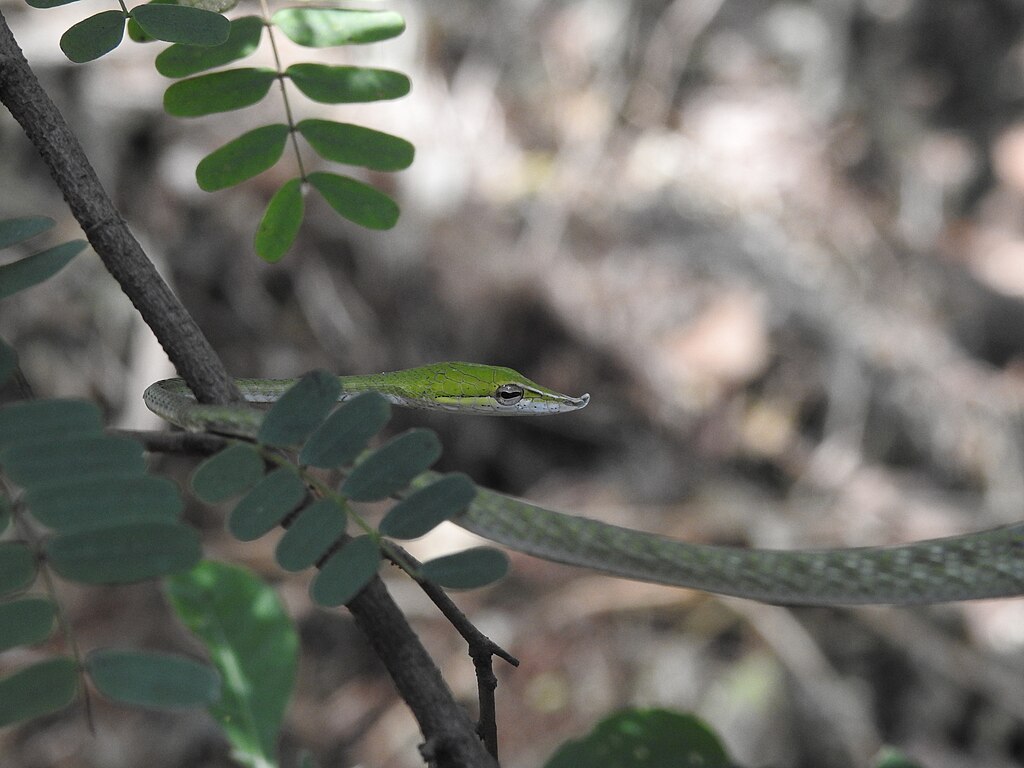
The vine snake possesses one of the most specialized visual systems among reptiles, with adaptations specifically evolved to support both its camouflage and hunting behaviors. Unlike most snakes that have round pupils, vine snakes feature horizontal, keyhole-shaped pupils that create an enhanced horizontal field of vision—perfect for detecting movement across the forest canopy. Their large, forward-facing eyes provide superior depth perception crucial for accurately striking at prey from precise distances. Research suggests these snakes can perceive a broader spectrum of colors than many other reptiles, potentially allowing them to better match their surroundings and detect colorful prey against green foliage. Most fascinating is their ability to maintain visual focus while performing their swaying movements, a challenging task that requires specialized neural connections between visual processing centers and motor control systems. This visual acuity represents a significant evolutionary investment, highlighting just how central vision is to this species’ survival strategy.
The Chemistry of Camouflage

The brilliant green coloration that enables the vine snake’s camouflage results from a sophisticated interplay of pigments and structural colors in its scales. Unlike mammals that primarily use pigments for coloration, reptiles often combine pigments with structural elements that reflect and refract light in specific ways. The vine snake’s scales contain specialized cells called chromatophores that house different pigments, primarily yellows and blues, which combine to create the dominant green appearance. Some individuals possess limited color-changing abilities, adjusting their shade to better match particular surroundings through the expansion and contraction of these chromatophores. The snake’s coloration isn’t uniform throughout its body, instead featuring subtle variations that create a more natural, leaf-like appearance. Recent research has even identified specialized nanostructures within the scales that enhance the matte appearance by scattering light in ways that reduce shine and shadow, further supporting the leaf illusion even under different lighting conditions throughout the day.
Sensory Awareness While Disguised
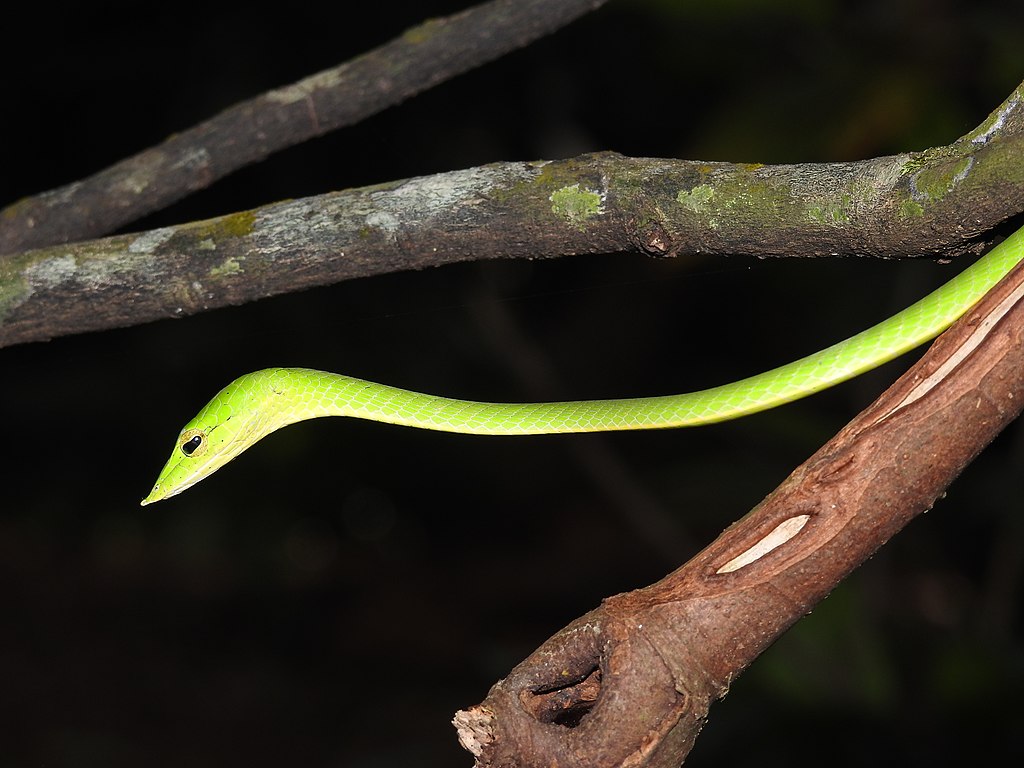
Maintaining effective camouflage requires the vine snake to remain extraordinarily still for extended periods, yet it must simultaneously stay alert to both potential threats and hunting opportunities. The snake accomplishes this balancing act through a remarkable sensory system adapted to function while in disguise. Its tongue flicks gather chemical information without requiring large movements that might break the illusion, allowing it to “taste” the air for predator and prey scents while appearing motionless. Specialized scale structures along its body contain highly sensitive mechanoreceptors that detect the slightest air movements or vibrations, providing awareness of approaching animals without the need for visual confirmation. Perhaps most impressive is the snake’s ability to detect and process multiple sensory inputs simultaneously, maintaining its disguise while tracking prey movement, monitoring for predators, and adjusting its position to match surrounding vegetation movements. This multitasking capacity represents a sophisticated neural adaptation that allows the snake to remain in character as a leaf while still functioning as an effective predator.
Regional Variations in the Technique
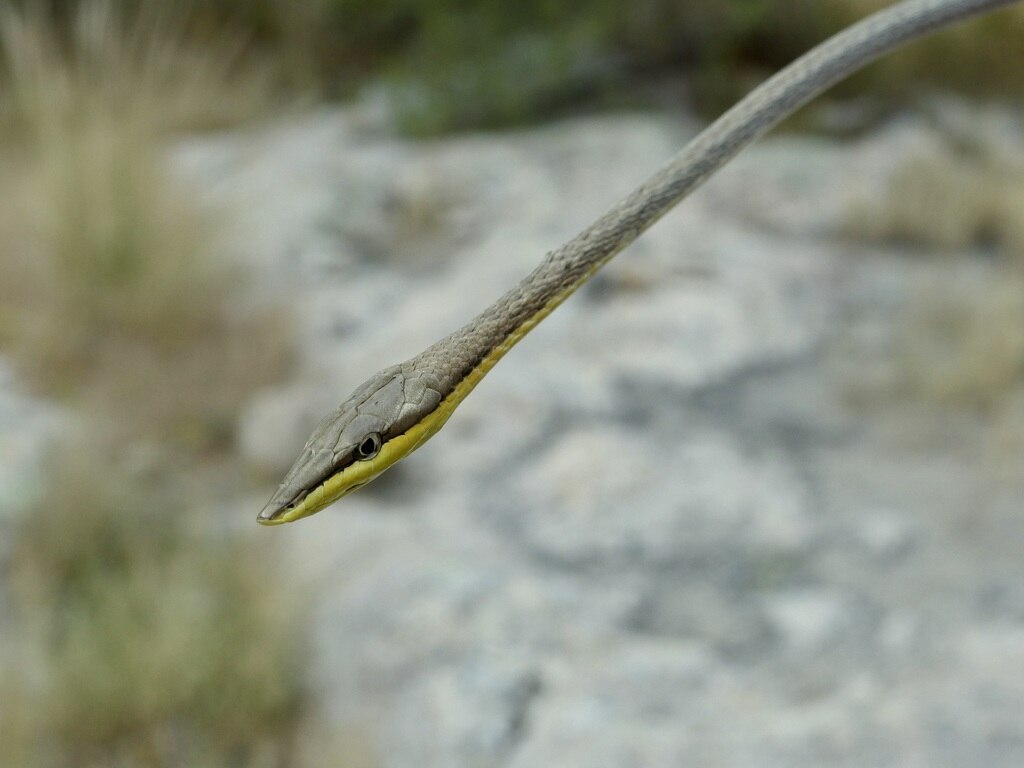
The vine snake’s leaf-mimicking behavior shows fascinating adaptations across its extensive geographic range, with regional variations reflecting local environmental conditions. In the dense rainforests of Borneo, vine snakes tend to display more exaggerated swaying behaviors that match the more pronounced leaf movements in these humid, often breezy environments. Populations in the drier, more seasonal forests of northern Thailand have developed slightly different coloration patterns that better match the occasionally yellowing vegetation of the dry season. Researchers have observed that island populations, particularly in the Philippines and parts of Indonesia, often show more specialized mimicry behaviors than mainland counterparts, likely due to increased predation pressure and evolutionary isolation. Even within a single region, individual snakes may develop personalized variations of the basic technique, with some specializing in mimicking specific plant species that are abundant in their immediate territory. These regional adaptations highlight the remarkable plasticity of this behavior and suggest it continues to evolve in response to local conditions and challenges.
Other Animals with Similar Strategies
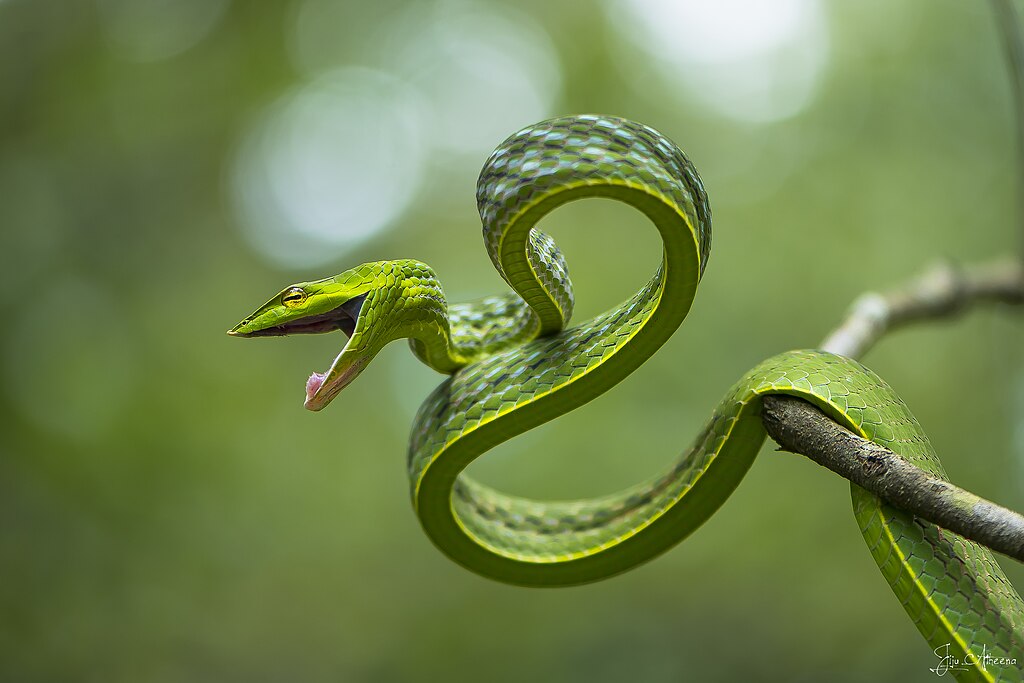
The vine snake’s leaf-mimicking behavior, while extraordinarily sophisticated, represents just one example of motion-based camouflage in the natural world. The Malaysian leaf insect (Phyllium sp.) combines its leaf-like appearance with a distinctive swaying walk that mimics leaves moving in a breeze, using a convergent evolutionary strategy despite being separated from vine snakes by hundreds of millions of years of evolution. Several mantis species, particularly the ghost mantis (Phyllocrania paradoxa), combine leaf-like appendages with rhythmic rocking movements that replicate wind-blown vegetation. In marine environments, the leafy seadragon (Phycodurus eques) employs similar strategies, using leaf-shaped appendages and a swaying swimming pattern to blend with seaweed. Even some birds, like certain nightjars, will sway gently when threatened, mimicking branches moving in the wind. These parallel adaptations across different animal groups demonstrate how motion-based camouflage represents a powerful evolutionary solution that has emerged independently multiple times.
Conservation Challenges

Despite their remarkable adaptations, vine snakes face significant conservation challenges that threaten their future survival. Habitat destruction represents the most immediate threat, with rainforest deforestation across Southeast Asia eliminating critical canopy environments these specialized hunters require. The pet trade places additional pressure on wild populations, with the snake’s unusual appearance and behaviors making it desirable to exotic reptile collectors, leading to ongoing collection despite regulations in many countries. Climate change poses perhaps the most insidious threat, as rising temperatures and changing precipitation patterns alter the forest structures these snakes have so perfectly adapted to over millions of years. Their specialized nature makes vine snakes particularly vulnerable to environmental changes, as their extreme adaptations for a specific ecological niche provide limited flexibility to adapt to rapidly changing conditions. Conservation efforts currently focus on habitat preservation and strengthening international trade regulations, though the secretive nature of these snakes makes population monitoring challenging.
Cultural Significance and Human Perception

The vine snake’s remarkable mimicry has earned it a special place in both scientific study and cultural traditions across its range. In traditional Thai and Malaysian folklore, these snakes were often regarded as forest spirits or manifestations of plant life given animal form, with various regional names translating roughly to “living vine” or “branch that hunts.” Their almost magical ability to transform between animal and plant appearance made them symbols of transformation in some indigenous spiritual practices. Western scientific interest in these snakes dates back to colonial naturalists, with detailed descriptions appearing in the journals of Alfred Russel Wallace during his explorations of the Malay Archipelago in the mid-19th century. In contemporary culture, vine snakes have featured prominently in wildlife documentaries, where their hunting techniques and camouflage behaviors create compelling footage that showcases nature’s ingenuity. For researchers studying biomimicry and adaptive behaviors, these snakes represent a continuing source of inspiration, with their techniques potentially informing developments in fields ranging from robotics to military camouflage technology.
Conclusion

The vine snake represents one of nature’s most perfect examples of evolutionary specialization—a creature that has so thoroughly adapted to its environment that it has essentially become part of it. Through millions of years of natural selection, these remarkable reptiles have developed not just the appearance but the behaviors needed to transform themselves into convincing imitations of vegetation. Their success demonstrates how powerful the forces of predation and survival can be in shaping species toward extraordinary specialization. As we continue to learn more about these masters of disguise, they remind us that in nature, the line between what seems alive and what doesn’t can be artfully blurred, and that sometimes the most effective survival strategy is to hide in plain sight, swaying gently with the forest breeze.





